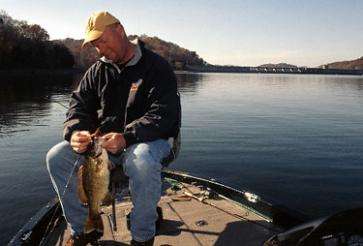
When I was a kid, I couldn’t wait for summer. It was the best time of the year. School was out and I could go fishing with my dad and friends. It was great.
Now that I’m just a little older (nearly 46), summer doesn’t mean quite as much to me. When you work for a living, summer days are just other work days — only much, much hotter.
But there are still some great things about summer that I look forward to every year. First of all, it’s the most stable time of the year. When you get on a good summertime smallmouth pattern, it can last for weeks or months instead of just hours or days.
Second of all, there are some summertime techniques that I dearly love and look forward to using each year. If we didn’t have summer, I’d miss them as much as ice cream and the 4th of July.
Summer definitely offers some challenges to the smallmouth angler. First of all, traffic on the water is at an all-time high with skiers, personal watercraft, swimmers, tubers and other fishermen. You really have to pick your spots and timing to be successful.
Assuming you want to catch your fish during daylight hours (we’ll cover night fishing in the next few columns — it’s a real passion of mine), there are a couple of things you can do to beat the heat and other problems we face in summer. Here’s what I recommend:
1. Get out there early.
Most of your vacationers who want to ski and ride around in their boats don’t get up very early in the morning, so that’s when you need to be on the water. If you’re waiting for safe light to start your drive to the lake, you’re waiting too long. You need to be there and ready to take off when it’s light enough to see.
2. Find moving water.
If you live near a good smallmouth river or stream, now is the time to fish it. Smallies in moving water act differently than those in lakes and reservoirs. They stay more active even on the hottest days.
If you don’t live near a river or stream with brown bass but your lake is used for producing electricity, you need to call the pumping station and find out when they’ll be generating. Those turbines that pull water will create a current in your reservoir that will help to activate the baitfish, which then activates the bass. You want to be on the water when that’s happening — even if it’s the middle of the day.
3. Do something different.
With so many people on the water at this time of year, it becomes extremely important to find a way to distinguish your bait or presentation from all the others. There are an infinite number of ways to do this, but a couple of my favorites are ripping jigs and using swimbaits.
Lots of anglers fish jigs for smallmouths, but few use the ripping or stroking retrieve. It’s easy. Just cast to the area you believe holds bass, let the bait sink to the bottom and then rip it off the bottom almost like you’re setting the hook on a strike. This causes the jig to leap off the bottom and then fall all the way back down. It will frequently excite the bass into striking and turns a finesse lure — the jig — into a reaction bait.
Swimbaits are all the rage for largemouths, but they work for brown fish, too. My favorite is the 5-inch Berkley Hollow Belly in Tennessee shad. It looks just like a baitfish swimming through the water, and smallmouths aren’t yet used to seeing such big lures. You might just set the hook on the fish of a lifetime!
Until next time, if you have any questions or comments, I’d love to hear from you. Please e-mail me atStephen@thesmallmouthguru.com.





